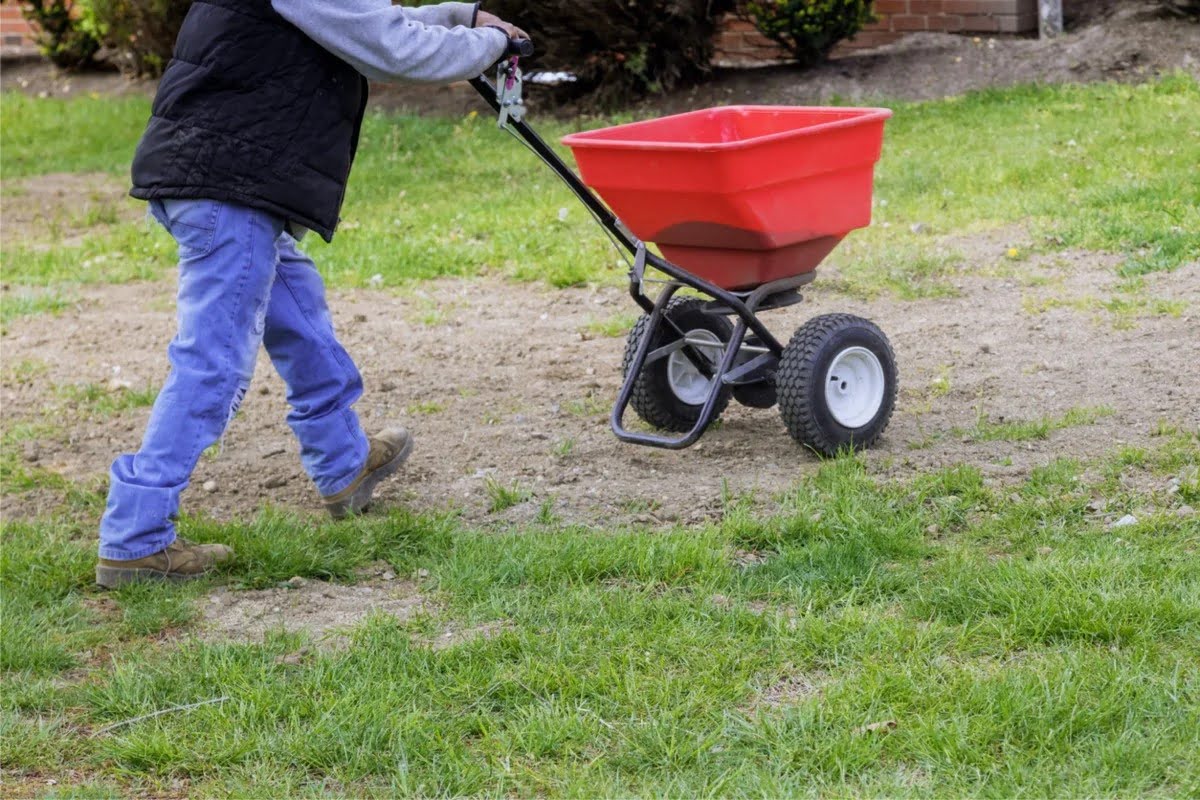Home>Garden Essentials>How Much Seed To Use When Overseeding


Garden Essentials
How Much Seed To Use When Overseeding
Modified: March 15, 2024
"Learn how much seed to use when overseeding your garden for optimal growth and success. Discover expert tips and techniques for a bountiful garden."
(Many of the links in this article redirect to a specific reviewed product. Your purchase of these products through affiliate links helps to generate commission for Storables.com, at no extra cost. Learn more)
Introduction
Welcome to the world of gardening! Whether you are a seasoned gardener or just starting out, there is always something new to learn. If you are looking to revitalize your lawn and bring it back to its lush and vibrant glory, then overseeding might just be the solution you are looking for.
Overseeding is a technique that involves spreading grass seed over an existing lawn to fill in sparse areas, promote new growth, and enhance the overall health and appearance of the turf. It is a cost-effective and efficient way to improve the quality of your lawn without completely starting from scratch.
In this article, we will explore the factors to consider before overseeding, delve into understanding seed coverage rates, learn how to calculate the appropriate seed quantity for overseeding, and provide useful tips for achieving optimal results. We will also highlight some common mistakes to avoid to ensure your overseeding efforts are successful. So, let’s get started!
Key Takeaways:
- Don’t Overdo It: When overseeding your lawn, use the recommended seed coverage rate to avoid overcrowding and poor germination. Proper preparation and timing are key for successful results.
- Patience Pays Off: Overseeding takes time and care. Avoid common mistakes like overwatering and neglecting maintenance to achieve a lush, vibrant lawn.
Read more: How Much Grass Seed For Overseeding
Factors to Consider Before Overseeding
Before you grab your bags of grass seed and start overseeding, there are a few important factors to consider. These factors will help ensure that your overseeding efforts are successful and yield desired results. Let’s take a look at them:
- The condition of your existing lawn: Assess the overall health and condition of your lawn. Are there bare patches, thin areas, or areas with poor grass growth? Understanding the state of your lawn will help you determine the extent of overseeding required.
- The type of grass: Identify the type of grass you currently have. Different grass species have varying growth habits, maintenance requirements, and resistance to certain environmental conditions. It is important to choose a grass seed that is compatible with your existing grass for consistent growth and uniform appearance.
- Local climate and growing conditions: Consider the climate and growing conditions in your region. Some grass species prefer warm climates, while others thrive in cooler temperatures. Additionally, consider factors such as sun exposure, shade, soil type, and moisture levels. Choose grass seed varieties that are well-suited to your specific growing conditions.
- Timing: Timing is crucial when it comes to overseeding. Generally, the best time to overseed is during the early fall or spring when the soil temperatures are cooler, allowing for optimal seed germination. Avoid overseeding during extreme weather conditions, such as during periods of drought or excessive heat.
- Preparation: Properly prepare your lawn before overseeding. This includes mowing the existing grass to a shorter height, removing debris, dethatching if necessary, and aerating the soil. These steps will help create an optimal environment for seed-to-soil contact and encourage seedling growth.
By carefully considering these factors, you will be able to make informed decisions and take the necessary steps to ensure a successful overseeding project. Remember, a healthy and well-prepared lawn is the foundation for successful overseeding and achieving a lush, vibrant, and resilient turf.
Understanding Seed Coverage Rates
When it comes to overseeding, understanding seed coverage rates is crucial for achieving optimal results. Seed coverage rate refers to the amount of grass seed required to adequately cover a given area. It is usually measured in pounds of seed per 1,000 square feet (or sq. m) of lawn.
The seed coverage rate may vary depending on the type of grass seed and the specific needs of your lawn. Different grass species have different seed sizes, germination rates, and growth habits, which can affect the recommended coverage rate. It is important to refer to the seed packaging or consult with a local gardening expert to determine the appropriate seed coverage rate for your specific grass variety.
Generally, the recommended seed coverage rate falls between 2 to 4 pounds per 1,000 square feet of lawn. However, this can vary based on factors such as the existing grass density, soil conditions, and desired results.
It is important to note that overseeding does not require as much seed as starting a lawn from scratch. The purpose of overseeding is to fill in bare patches and promote new growth, not to completely cover the existing turf. Applying too much seed can lead to overcrowding, competition for resources, and poor germination.
To properly gauge the amount of grass seed needed, it is essential to accurately measure the size of your lawn. Use a measuring tape or a digital measuring tool to determine the square footage of the area to be overseeded. This will help you calculate the appropriate quantity of seed required.
Remember, following the recommended seed coverage rate is important to ensure successful overseeding. Using too little seed may result in patchy coverage and limited establishment of new grass, while using too much seed can lead to overcrowding and increased competition for water, nutrients, and sunlight.
By understanding and adhering to the seed coverage rate guidelines, you can achieve balanced seed distribution, maximize germination, and promote healthy turf growth for a beautiful and resilient lawn.
Calculating Seed Quantity for Overseeding
Calculating the right quantity of grass seed for overseeding is essential to ensure proper coverage and successful establishment of new grass. By following a few simple steps, you can determine the amount of seed needed for your specific lawn.
Here’s how you can calculate the seed quantity for overseeding:
- Measure your lawn: Start by measuring the area of your lawn that requires overseeding. Use a measuring tape or a digital measuring tool to determine the square footage of the area.
- Determine the recommended seed coverage rate: Refer to the packaging of your chosen grass seed or consult with a local gardening expert to determine the recommended seed coverage rate. This is usually mentioned as pounds of seed per 1,000 square feet of lawn.
- Calculate seed quantity: Divide the square footage of your lawn by 1,000 to determine the number of 1,000 square foot areas. Multiply this by the recommended seed coverage rate to get the total seed quantity in pounds. For example, if your lawn is 5,000 square feet and the recommended coverage rate is 3 pounds per 1,000 square feet, the calculation would be: (5,000 ÷ 1,000) × 3 = 15 pounds of seed.
- Adjust for specific lawn conditions: Depending on the conditions of your lawn, you may need to adjust the calculated seed quantity. For areas with thinner grass coverage, bare spots, or poor growth, you may want to increase the seed quantity slightly to ensure better coverage. On the other hand, if your lawn already has dense grass coverage, you can reduce the seed quantity to avoid over-seeding.
- Divide seed quantity for multiple applications: If you have a large lawn, you may find it easier to divide the seed quantity and perform overseeding in multiple applications. This will help ensure more even coverage and prevent wastage of seed.
Calculating the seed quantity for overseeding allows you to plan and purchase the right amount of seed for your lawn. By following these steps and adjusting the quantity according to your specific lawn conditions, you can achieve even seed distribution, healthy germination, and vigorous growth of new grass.
When overseeding a lawn, use 1 to 2 pounds of grass seed per 1,000 square feet for best results. This will help fill in bare spots and promote a thicker, healthier lawn.
Adjusting Seed Quantity for Different Turf Conditions
When it comes to overseeding, adjusting the seed quantity is important to account for different turf conditions and achieve optimal results. Depending on the thickness of your existing grass, the health of the soil, and the desired outcome, you may need to increase or decrease the amount of seed used for overseeding.
Here are some guidelines for adjusting the seed quantity based on different turf conditions:
- Thin or sparse grass coverage: If your lawn has thin grass coverage or areas with sparse growth, increasing the seed quantity can help achieve better coverage. Adding a slightly higher seed quantity to these areas can fill in the gaps and promote more uniform growth.
- Bare spots or patches: For bare spots or patches where no grass is present, you may need to use a higher seed quantity compared to the rest of the lawn. These areas require special attention and additional seed to establish new grass growth.
- Dense grass coverage: In areas where the existing grass is thick and abundant, reducing the seed quantity can prevent overcrowding and competition between the new and existing grass. This will ensure that each seedling has enough space and resources to grow.
- Soil quality: If your soil is nutrient-rich and has good drainage, it can support healthy grass growth. In such cases, the recommended seed coverage rate may be sufficient. However, if your soil is lacking in nutrients or has poor drainage, increasing the seed quantity can compensate for these conditions and improve establishment.
- Desired outcome: Consider your desired outcome when adjusting the seed quantity. If you aim for a thicker and lusher lawn, you can increase the seed quantity slightly. If you prefer a more modest growth, a lesser seed quantity should suffice.
By assessing and adjusting the seed quantity based on different turf conditions, you can ensure that each section of your lawn receives the appropriate amount of seed for successful overseeding. This approach will promote even and healthy growth, resulting in a more vibrant and visually appealing lawn.
Read more: When To Mow Overseeded Grass
Tips for Achieving Optimal Results with Overseeding
Overseeding can be a highly effective way to rejuvenate your lawn and achieve a lush and vibrant turf. To maximize the success of your overseeding efforts, consider incorporating these tips into your plan:
- Choose the right grass seed: Select a high-quality grass seed that is well-suited to your specific growing conditions and matches the existing grass in your lawn. Look for varieties that are known for their germination rates, disease resistance, and ability to thrive in your climate.
- Prepare the lawn thoroughly: Properly prepare the lawn before overseeding to create an optimal environment for seed germination and establishment. This may involve mowing the existing grass to a shorter height, dethatching if necessary, removing debris, and aerating the soil. Aerating the soil will help improve seed-to-soil contact and ensure better absorption of water and nutrients.
- Overseed during the right season: Timing is crucial when it comes to overseeding. The best time to overseed is during the early fall or spring when the soil temperatures are cooler, allowing for optimal seed germination. Avoid overseeding during periods of extreme heat or drought as it may hamper seed germination and growth.
- Ensure proper seed-to-soil contact: Good seed-to-soil contact is essential for successful germination. After spreading the seed, gently rake or lightly tamp it into the soil to ensure it makes contact with the soil surface. This will help the seeds absorb moisture and nutrients, promoting healthy growth.
- Water consistently: Adequate and consistent watering is crucial for seed germination and establishment. Keep the seeded area moist by watering lightly and frequently, preferably with a sprinkler or irrigation system. Be careful not to overwater, as it can wash away the seed or lead to fungal diseases.
- Fertilize appropriately: Apply a slow-release, phosphorus-rich fertilizer to provide necessary nutrients for seedling growth. However, avoid using fertilizer with high nitrogen content, as it can promote excessive top growth at the expense of root development.
- Maintain proper lawn care practices: After overseeding, follow good lawn care practices to ensure the success of your efforts. Regularly mow the lawn at the recommended height, provide adequate watering, apply additional fertilizer as needed, and control weeds as they can compete with the new grass for resources.
- Be patient: Overseeding is a process that requires patience. It takes time for the new grass to germinate, establish roots, and fill in the existing lawn. Be consistent with your care and maintenance practices, and give the grass sufficient time to grow and develop.
By following these tips, you can increase the chances of achieving optimal results with your overseeding project. A well-prepared lawn, proper seed selection, and diligent maintenance will contribute to the growth of a lush and healthy turf that you can enjoy for years to come.
Common Mistakes to Avoid When Overseeding
While overseeding can be a highly effective way to improve your lawn, there are some common mistakes that many people make. By being aware of these mistakes and avoiding them, you can ensure the success of your overseeding project. Here are some common mistakes to avoid:
- Applying too much seed: One of the most common mistakes is applying an excessive amount of seed. Overly dense seed coverage can lead to competition for resources, poor germination, and weak seedling growth. Follow the recommended seed coverage rate for your specific grass type and adjust accordingly based on the conditions of your lawn.
- Skipping lawn preparation: Proper lawn preparation is crucial for overseeding success. Skipping steps like mowing, dethatching, removing debris, and aerating the soil can hinder seed-to-soil contact and restrict the germination and growth of new grass. Take the time to prepare your lawn before overseeding for optimal results.
- Overwatering or underwatering: Watering is essential for seed germination, but it’s important to strike the right balance. Overwatering can lead to rot or fungus problems, while underwatering can prevent adequate seed germination. Water the seeded area lightly and frequently, keeping the soil consistently moist but not saturated.
- Mowing too soon: Resist the temptation to mow your lawn too soon after overseeding. Give the new grass seedlings enough time to establish roots and gain strength before subjecting them to mowing. Typically, wait until the new grass reaches a height of 3 to 4 inches before mowing, and be sure to use a sharp blade to avoid damaging the seedlings.
- Neglecting regular maintenance: Once you have overseeded, it’s important to continue with regular lawn care maintenance. This includes regular mowing, proper watering, and appropriate fertilization. Neglecting these essential maintenance practices can compromise the health and growth of the new grass.
- Overlooking weed control: Weeds can quickly take advantage of the bare areas created by overseeding. Before overseeding, address weed issues by applying herbicides or manually removing weeds. After overseeding, continue to monitor and control any weed growth to prevent them from overpowering the newly growing grass.
- Not adjusting seed quantity for unique conditions: Every lawn is unique, and it’s important to adjust the seed quantity according to its specific conditions. Factors like thin grass coverage, bare spots, soil quality, and climate should be taken into account when determining the seed quantity for overseeding.
- Being impatient: Overseeding takes time and patience. It can take several weeks or even months for the new grass to fully establish and blend with the existing lawn. Avoid the temptation to rush the process and be patient. Continue to provide proper care and maintenance, and allow the grass to grow and fill in naturally.
By being mindful of these common mistakes and taking the necessary precautions, you can ensure a successful overseeding project. Avoiding these pitfalls will contribute to the growth of healthy, lush grass, and a beautiful lawn you can be proud of.
Conclusion
Overseeding is a valuable technique that can rejuvenate your lawn, filling in sparse areas, promoting new growth, and enhancing the overall appearance and health of your turf. By understanding the factors to consider before overseeding, seed coverage rates, and how to calculate the appropriate seed quantity, you can embark on a successful overseeding project.
Remember to adjust the seed quantity based on different turf conditions and follow a few tips to achieve optimal results. Choose the right grass seed, prepare your lawn thoroughly, overseed during the right season, ensure proper seed-to-soil contact, water and fertilize appropriately, and maintain good lawn care practices. By avoiding common mistakes such as applying too much seed, skipping lawn preparation, overwatering or underwatering, neglecting maintenance, overlook weed control, not adjusting seed quantity, and being impatient, you can ensure a successful overseeding endeavor.
Keep in mind that overseeding is a process that requires patience and consistent care. It may take time for the new grass to germinate and establish, but with proper maintenance and attention, your lawn will gradually become lush, vibrant, and resilient.
By incorporating the techniques and tips discussed in this article, you can achieve a beautiful lawn that will be the envy of your neighborhood. So, grab your grass seed, get out there, and start overseeding – your lawn will thank you!
Frequently Asked Questions about How Much Seed To Use When Overseeding
Was this page helpful?
At Storables.com, we guarantee accurate and reliable information. Our content, validated by Expert Board Contributors, is crafted following stringent Editorial Policies. We're committed to providing you with well-researched, expert-backed insights for all your informational needs.















0 thoughts on “How Much Seed To Use When Overseeding”